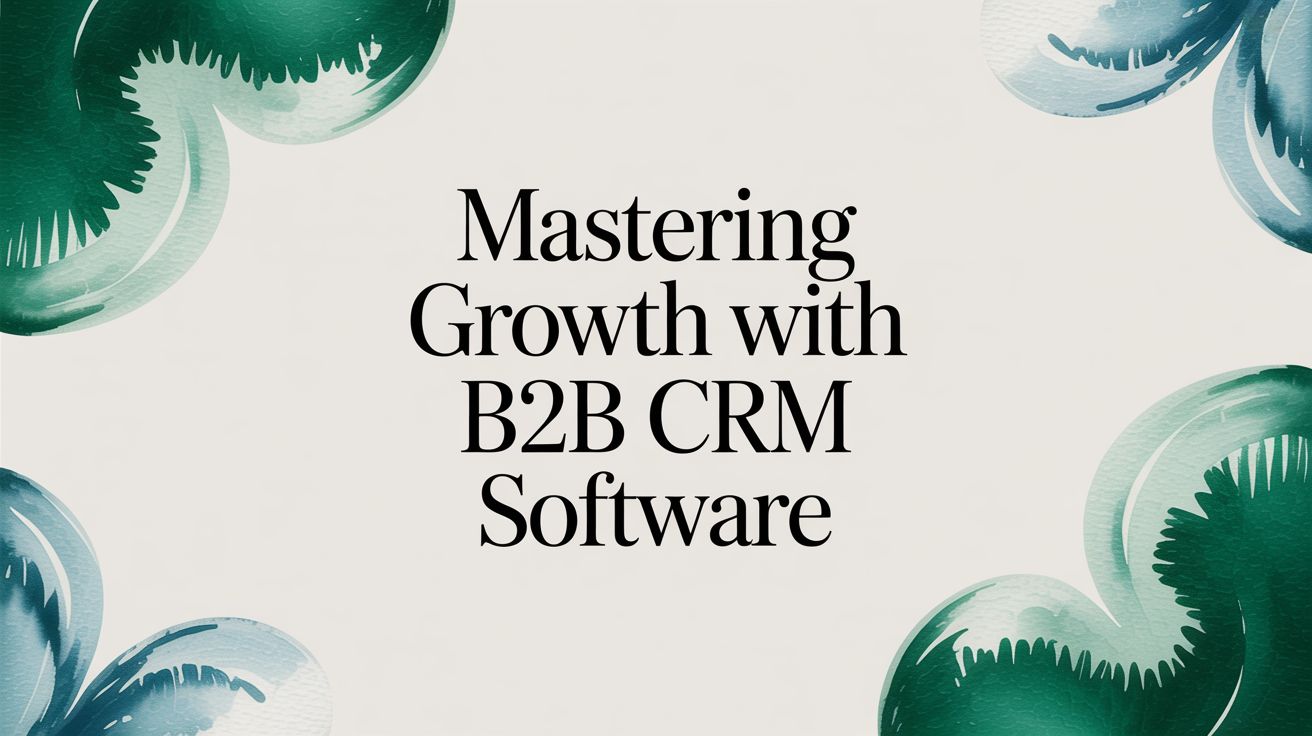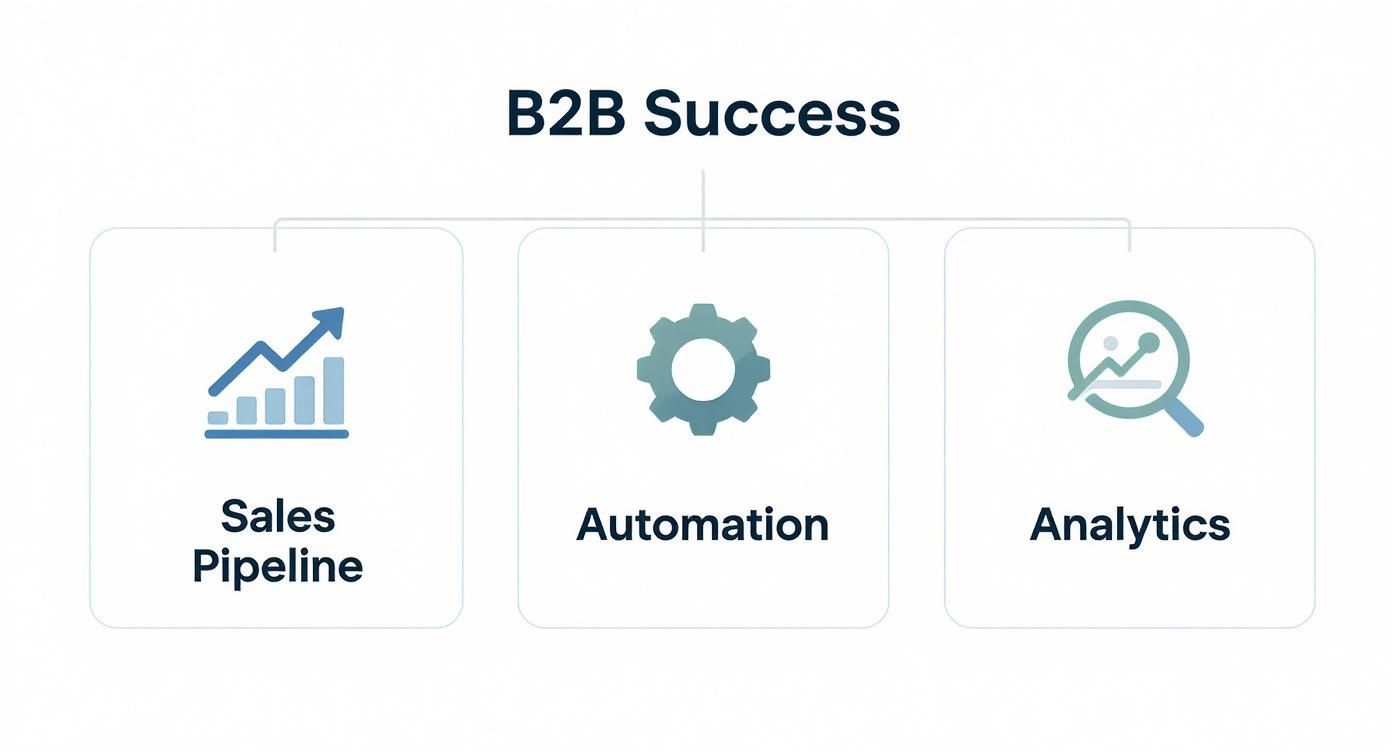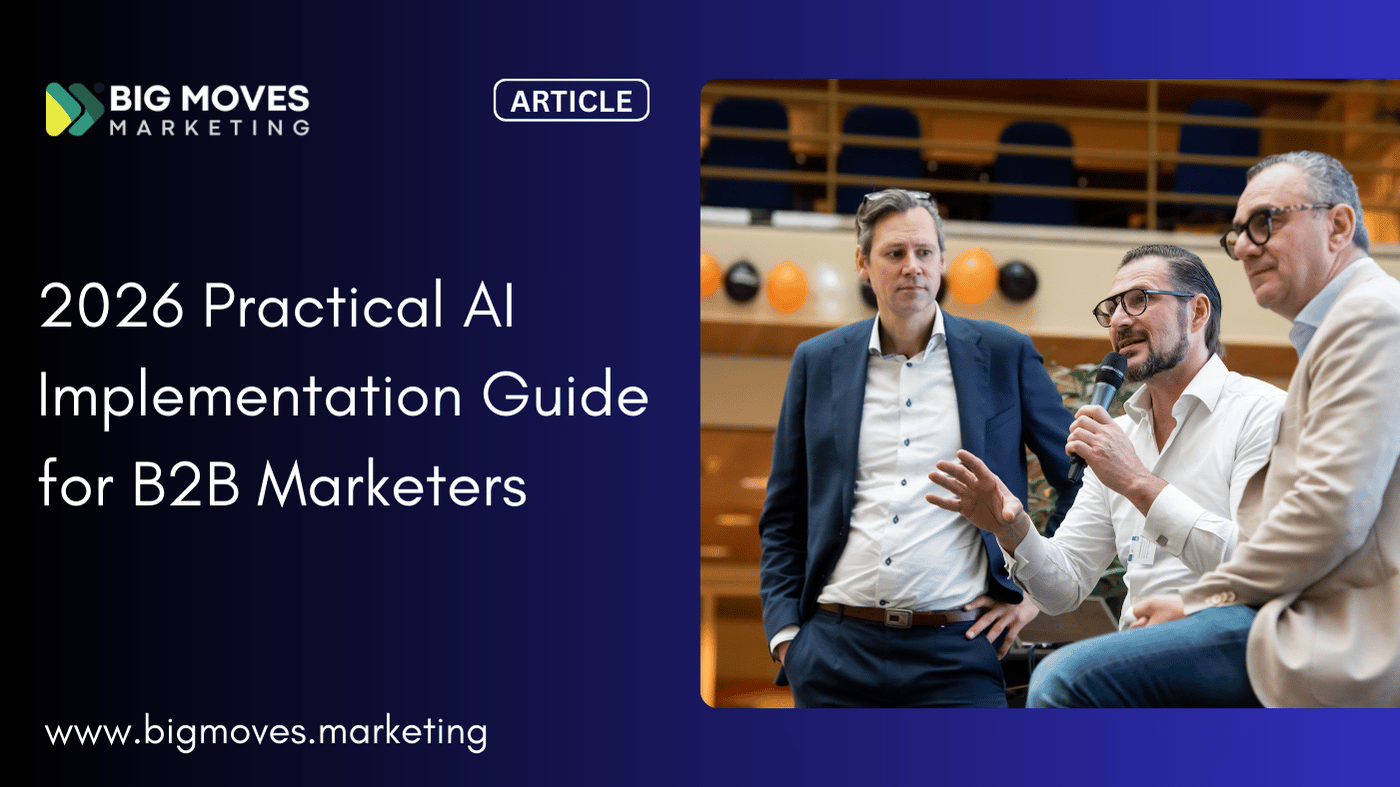Mastering Growth with B2B CRM Software
October 24, 2025

Think of B2B CRM software as the central nervous system for your business relationships. It’s a specialized platform that connects every single customer interaction—every call, email, and meeting—into one cohesive, intelligent whole, specifically designed for the long, complex world of business-to-business deals.
Your Blueprint for Lasting Business Relationships

Ever seen a skyscraper go up without a blueprint? It’s unthinkable. The result would be chaotic, risky, and destined to crumble. Trying to manage complex B2B relationships without a dedicated system feels exactly the same. Each disconnected spreadsheet, forgotten email, and siloed department is a structural weakness waiting to cause a collapse.
A B2B CRM software acts as that essential architectural plan for your company's growth. It’s so much more than a digital address book; it becomes the single source of truth that finally gets your sales, marketing, and service teams on the same page. This unity ensures every interaction is informed, strategic, and builds on the last one.
The Foundation of Strategic Growth
In the B2B market, success is rarely about a single, quick sale. It’s about cultivating a relationship over months or even years, navigating multiple decision-makers, and handling intricate negotiations. A powerful CRM gives you the framework to manage this entire journey with purpose and clarity.
This system is purpose-built to handle the unique headaches of B2B deals:
- Long Sales Cycles: It meticulously tracks dozens of touchpoints over an extended period, so no lead ever falls through the cracks.
- Multiple Stakeholders: It helps you map out all the key players within a target company, from the enthusiastic end-user to the skeptical CFO.
- High-Value Deals: When significant revenue is on the line, it provides the detailed oversight you absolutely need to close with confidence.
Ultimately, a B2B CRM shifts your entire approach from reactive to proactive. Instead of just responding to customer needs as they arise, you start anticipating them. That shift is what separates the market leaders from everyone else.
A well-implemented B2B CRM doesn't just store data; it provides the intelligence to act on it. It reveals patterns, highlights opportunities, and guides your team toward more meaningful and effective engagement at every stage.
From Disconnected Data to Unified Vision
The real magic of this software is its ability to pull everything together. Every phone call, marketing email, support ticket, and meeting note is captured in one central, accessible place. This unified view empowers your organization to present a consistent and professional front to every client, every single time.
By understanding the complete history of an account, your teams can create a truly seamless customer experience. This is fundamental to navigating the winding path of a B2B customer journey map, making sure each touchpoint builds trust and moves the relationship forward. It’s the difference between a series of random encounters and a deliberately crafted, successful partnership.
The Core Features That Power B2B Success
So, what's actually under the hood of a good B2B CRM? Beyond the big promises, the real value lies in a handful of core features. These aren't just bullet points on a sales page; they're the engine that turns messy data into real revenue and lasting customer relationships.
Let’s break down exactly how these tools bring order and intelligence to the complex world of B2B sales, moving your CRM from a passive database into an active partner in your growth.
Transforming Contacts Into Opportunities
At its heart, a B2B CRM is all about contact and lead management. Think of it as upgrading from a clunky, static spreadsheet to a living, breathing history of every single person and company that matters to your business. It’s not just names and numbers; it’s the full story of your interactions.
Imagine a sales rep is about to call a key contact. With a quick glance, they can see this person downloaded a whitepaper two months ago, joined a webinar last week, and even chatted with a support agent about a specific problem. That 360-degree view means every conversation starts with context and builds trust, instead of feeling like a cold call.
This feature is your safety net. When a key team member moves on, the entire relationship history stays right where it belongs—with your company, ready for a seamless handover. No more lost opportunities.
Visualizing Your Path to Revenue
One of the most powerful tools in any B2B CRM is sales pipeline visualization. Forget guessing where your deals are. A CRM lays out your entire sales process on a clear, visual board, often with drag-and-drop cards for each deal. Every stage—from "Initial Contact" to "Negotiation" and "Closed-Won"—is right there in front of you.
This clarity is a game-changer for sales managers. You can spot bottlenecks in an instant. Are too many deals getting stuck in the "Proposal Sent" stage? That’s a clear signal to investigate your pricing, proposal quality, or follow-up strategy. This visual map of your revenue stream turns gut feelings into data you can actually use.
A visual pipeline doesn't just track progress; it inspires action. It shows your team exactly where they are and what they need to do next to hit their goals, creating momentum and focus.
The financial impact is hard to ignore. Studies show that firms using CRM software see an average return on investment (ROI) of $8.71 for every dollar spent. On top of that, reps using a CRM experience an average 41% increase in revenue because these streamlined processes let them focus on what they do best: selling.
Automating the Work That Slows You Down
B2B sales and marketing are filled with repetitive, time-consuming tasks. Sending follow-up emails, updating contact records, assigning leads to reps—it’s all necessary, but it’s not where the real value is created. Automation is the feature that handles this busywork, freeing your team to build relationships and close deals.
Picture this: a new lead fills out a form on your website. An automation workflow can instantly:
- Add the contact to the CRM with all their details.
- Assign the lead to the right sales rep based on territory or industry.
- Send a personalized welcome email.
- Schedule a follow-up task for the rep in three days.
This all happens in the background, ensuring every lead gets a prompt and consistent response. That's how you make a great first impression, every single time. To see just how deep this goes, check out our guide on how automation in B2B marketing can drive serious growth.
Making Decisions with Data, Not Guesses
Finally, we have the brain of the operation: robust reporting and analytics. This is where your B2B CRM gathers all the data flowing through your system and turns it into simple, easy-to-read dashboards and reports. It’s built to answer your most critical business questions.
With a few clicks, you can see which marketing campaigns are bringing in the best leads, how long your average sales cycle is, and which reps are crushing their targets. This data-driven foundation allows your leadership team to make smart, strategic decisions with confidence. It’s the end of guesswork and the beginning of a clear view of what’s working and what’s not.
Choosing the Right B2B CRM Architecture
Picking the right B2B CRM software is a lot like choosing a vehicle for a road trip. You wouldn't try to haul furniture in a sports car, and you wouldn't enter a Grand Prix in a minivan. The right choice comes down to your destination, your team, and the road ahead.
Not all CRM systems are built the same, and understanding the core architectural differences is your first step. This isn't just a technical detail; it determines how your teams work, how you understand your customers, and how fast you can act on new opportunities.
The Three Core CRM Models
Think of the three main types of B2B CRM software as different classes of vehicles, each designed for a specific job. Your main goal is to match the model to your company's primary objective.
Operational CRM: The Workhorse Truck. This is the most common type, built for action. It's all about streamlining the day-to-day work for your sales, marketing, and service teams. Like a reliable pickup truck, its main job is to handle the heavy lifting of customer interactions—from managing new leads to resolving support tickets. It's the engine of your customer relationships.
Analytical CRM: The F1 Race Car. This model is all about data, speed, and precision. It’s engineered to collect and analyze huge amounts of customer information to spot patterns, predict trends, and inform your biggest strategic bets. Just like a Formula 1 car, it's loaded with sensors and diagnostics to give you the insights needed to find a clear advantage.
Collaborative CRM: The Team Bus. This architecture is designed to get everyone on the same page and moving in the same direction. It breaks down the walls between departments—sales, marketing, technical support, you name it—to make sure information flows freely. Like a team bus, it ensures every player has the same playbook and can work together as one cohesive unit.
The decision tree below makes it clear: start with your primary goal—whether that's managing the sales pipeline, automating tasks, or digging for insights—and let that guide you to the right B2B CRM software.

As the graphic shows, your core business need should always be the starting point for your CRM search.
Deciding Between Cloud and On-Premise
Once you know what type of CRM you need, you have to decide where it’s going to live: in the cloud or on your own servers. This is a massive decision that affects everything from your budget and security to your IT team's workload.
Here’s a simple table to break down the key differences between the two main deployment models.
Cloud vs On-Premise B2B CRM Comparison
Ultimately, a cloud-based (SaaS) CRM is hosted by the provider and accessed online. You pay a subscription, and they handle all the technical issues. An on-premise CRM is installed on your company’s servers, giving you total control but also total responsibility.
The trend is crystal clear: flexibility and accessibility are winning. Today, a staggering 87% of CRMs are cloud-based, a huge leap from just 12% back in 2008.
This shift shows just how much modern businesses value being able to adapt quickly. As you weigh your options, reviewing some practical guidance on choosing CRM software can shed light on the core architectural questions any B2B company needs to ask.
The proof is in the numbers. As of 2024, an estimated 91% of businesses with more than 11 employees are using a CRM. It’s become an essential tool for managing the complex relationships that define B2B success. Picking the right architecture is your first step toward joining them.
The Real Benefits of B2B CRM Go Way Beyond Just Sales
Think of a B2B CRM system as more than just a fancy digital address book. It’s a catalyst for a ripple effect of positive change that touches every single corner of your business. Adopting one isn't just a tech upgrade; it’s a fundamental shift in how your entire organization communicates, operates, and grows.
https://www.youtube.com/embed/BvQbiG019Io
This isn't about small, incremental tweaks. We're talking about building an interconnected system where every team is armed with the same information, leading to massive improvements in how people work together. The true value of B2B CRM software is its ability to create one reliable source of truth that everyone can trust and rally around.
Breaking Down the Walls Between Departments
For way too long, sales and marketing have operated like two different countries with a heavily guarded border. Marketing generates leads, passes them over the wall, and hopes for the best. Meanwhile, sales is left wondering about the quality of what they just received.
That disconnect creates a ton of friction, wastes money, and, worst of all, gives the customer a clunky, disjointed experience. A B2B CRM is the ultimate peacekeeper, finally demolishing those barriers.
When both teams work from the same system, marketing can see exactly which campaigns are bringing in leads that actually close deals. This lets them sharpen their strategy with real data, not just vanity metrics. Sales gets the full picture of a prospect’s journey—every blog post they read, every webinar they attended—so they can have smarter, more relevant conversations right from the start.
This shared intelligence builds mutual respect and gets everyone working toward the same goals. For a deeper look at this dynamic, understanding how to start aligning sales and marketing teams is a great next step.
By creating a transparent, unified customer journey, a B2B CRM transforms departmental friction into a powerful, collaborative engine for growth. Every interaction becomes a building block, not an isolated event.
Ultimately, this alignment means the customer feels a seamless transition. They get consistent messaging and a personalized experience no matter who they’re talking to. That unified front is what builds trust and really makes your business stand out.
Keep More Customers by Being Proactive, Not Reactive
Let's be honest: landing a new B2B client is tough and expensive. Losing one is just devastating. A CRM is your best defense against churn because it flips your service model from putting out fires to preventing them in the first place.
Instead of waiting for a client to call with a problem, your team can see the warning signs and step in before things go south.
With a complete history of every interaction right at their fingertips, your customer success team can spot patterns. Maybe they notice a client’s product usage has dipped, or that they haven’t engaged with any new feature announcements. That’s a crystal-clear signal to reach out, offer some help, and show you’re invested in their success.
This kind of proactive, personal attention makes clients feel seen and understood, which is a massive driver for loyalty and retention.
Finally Get Forecasting You Can Actually Trust
For anyone in leadership, accurate forecasting is the holy grail. It drives everything from hiring plans to budget approvals and long-term strategy. Relying on a bunch of spreadsheets and gut feelings is a recipe for disaster.
A B2B CRM brings some much-needed discipline and data to this critical process.
By tracking every single deal in your pipeline—its value, what stage it’s in, and the probability of it closing—the system gives you a clear, real-time snapshot of future revenue. Sales managers can analyze performance with surgical precision, and executives can make big decisions based on reliable data, not just wishful thinking.
This level of clarity takes the guesswork out of the equation and empowers leadership to steer the ship with real confidence, setting the stage for stable, sustainable growth.
Your Practical Blueprint for Successful CRM Implementation

Let's be honest. Even the most powerful B2B CRM software is little more than an expensive, glorified database without a smart implementation plan. Success isn't about flipping a switch; it's about carefully building the foundation for an entirely new way of working. This blueprint gives you a real-world path to roll out your CRM, dodge the usual landmines, and get your team genuinely excited to use it.
The journey starts long before you even think about moving a single contact record. The most common mistake we see is treating this like a tech project. It’s not. It’s a business transformation project. For any major software undertaking, a well-run software development discovery phase is your best insurance policy against costly mistakes down the road.
Define Your Objectives and Assemble Your Champions
First things first: what does "success" actually look like? Get specific. Are you trying to shorten the sales cycle by 15%? Boost lead conversion rates? Maybe you need to increase customer retention. These goals become your North Star, guiding every single decision you make from here on out.
Once you know where you're going, pull together a cross-functional team. This can't just be the IT department. You need the real users—key players from sales, marketing, and customer service who will live in this system every day. Crucially, you also need a project champion, a leader who can secure buy-in and keep the momentum going when things get tough.
Master Your Data and Plan the Migration
Data migration is where most CRM projects go off the rails. It's often the hardest part. Think of it less like moving boxes from one house to another and more like performing a delicate organ transplant. If you adopt a "garbage in, garbage out" mentality, you're dooming the project from day one.
Start by auditing and cleaning up the data you already have. This means:
- De-duplicating all those extra contacts and accounts.
- Standardizing formats so everything looks consistent.
- Archiving old, irrelevant information that's just clutter.
With clean data in hand, map out your migration. A great way to do this is to start small. Take a manageable chunk of data for a pilot program, test the process, and work out the kinks before you go all-in on a full-scale migration.
A successful CRM rollout is built on clean data and enthusiastic users. Prioritizing data hygiene before migration and focusing on the 'what's in it for me' during training are the two most critical factors for achieving a high return on your investment.
Drive Adoption with a Focus on People
The real test of your B2B CRM software's success is simple: do people actually use it? To get your team on board, you have to show them how this new system makes their lives easier and helps them hit their targets. Don't just train them on features; demonstrate the direct, personal benefits.
For example, show a salesperson how automation can wipe out hours of manual data entry, freeing them up to build relationships and close deals. Show them how having all customer info in one place gives them instant context before a client call, leading to smarter conversations. Having a solid plan is vital, and this checklist for B2B SaaS sales and marketing execution can provide a fantastic framework.
The sheer size of the global CRM market shows just how much value big companies place on these systems. The United States alone makes up 37% of worldwide CRM software spending, with large enterprises contributing about 73.8% of that total. This massive investment highlights just how critical it is to get the implementation right to unlock all that promised value.
Common Questions About B2B CRM Software
Stepping into the world of B2B CRM software always brings up a flood of questions. That’s perfectly normal. It's a big decision that can fundamentally change how your business operates, so having a few concerns about the specifics is a good sign you're taking it seriously.
To help you move forward with confidence, we've gathered and answered some of the most common questions we hear from decision-makers when they're considering making this move. Think of this as your quick-start guide to the practical details.
How Is B2B CRM Different From B2C CRM
At a glance, B2B and B2C CRMs might seem like two sides of the same coin—they both manage customer relationships, right? But underneath the surface, they're engineered for completely different worlds. It’s like comparing a surgeon’s scalpel to a chef’s knife. Both are cutting tools, but they’re built for vastly different levels of complexity and purpose.
A B2C (business-to-consumer) CRM is all about speed and volume. It's designed to handle thousands, even millions, of individual customers in a fast-paced, transactional environment. The focus is on mass marketing, quick sales cycles, and managing a ton of relatively small purchases.
A B2B CRM software platform, on the other hand, is built for depth and strategy.
- Complex Sales Cycles: B2B deals can take months, sometimes even years, involving multiple stages of negotiation and approval. The CRM is your map for this long, winding journey.
- Multiple Decision-Makers: You're not just selling to one person; you're selling to an entire buying committee. A B2B CRM helps you map out these key stakeholders and manage relationships with each of them individually.
- High-Value Relationships: B2B deals are typically much larger, so the name of the game is meticulous account management and building long-term, high-value partnerships.
In short, B2C is about managing many quick transactions. B2B is about cultivating a few highly strategic, long-term relationships.
How Long Does It Take to Implement a B2B CRM
There's no single answer here, as the timeline for implementing a B2B CRM can vary dramatically. It all comes down to the scale of your ambition and the complexity of your current setup. A small startup with clean data and straightforward needs might get a cloud-based CRM up and running in just a few weeks.
For a mid-sized or large enterprise, however, the process is much more involved. Factors like migrating massive amounts of data from legacy systems, customizing workflows to fit your unique sales process, and integrating the CRM with other critical tools like an ERP or accounting software can easily stretch the timeline to anywhere from three to nine months.
The most successful implementations are never rushed. They are treated as a strategic business initiative, not just another IT project. A phased rollout, starting with a pilot group and core features, is almost always the smartest approach to ensure a smooth transition and get enthusiastic buy-in from your team.
This careful, measured approach prevents everyone from getting overwhelmed and lets you fine-tune the system based on real-world feedback before a company-wide launch.
Can a CRM Integrate With Our Existing Tools
Absolutely—and it's a deal-breaker if it can't. Integration isn't just a "nice-to-have" feature anymore; it's the bedrock of any modern B2B CRM. Your business probably runs on a whole suite of specialized tools—email marketing platforms, communication apps like Slack, accounting software, and project management systems. A CRM that can't talk to these other tools just creates another data silo, which is the exact problem you’re trying to solve.
Most leading CRMs offer a marketplace full of pre-built, one-click integrations with popular business apps. For any custom or proprietary software you're using, CRMs also provide APIs (Application Programming Interfaces). An API acts as a secure bridge, allowing your developers to build custom connections between your CRM and literally any other system.
The goal is to create a single, unified command center for all customer-related information. This seamless flow of data is what truly empowers your teams to work more efficiently and make smarter, faster decisions.
What Is the Biggest Mistake Companies Make With a CRM
The single biggest—and most expensive—mistake is treating a CRM implementation as a technology purchase instead of a fundamental business strategy. So many companies fall into this trap. They buy a powerful piece of software, hand it over to their team, and just expect the magic to happen. When it inevitably fails to gain traction, they blame the tool.
But the software is rarely the real problem. The issue is almost always a lack of a clear "why."
Success hinges on defining your business goals first. Before you even look at a single demo, you should be able to answer questions like: What specific problems are we trying to solve? How will this system help our sales team close more deals? What process will it improve for our customer service team?
Involving your end-users from the very beginning, providing thorough training that focuses on the benefits (not just the features), and getting strong, visible support from leadership are all non-negotiable. At the end of the day, a B2B CRM is a tool meant to empower your people and streamline your processes. For a deeper dive on what to track, exploring a guide to customer success metrics can provide valuable context on what truly matters.
Ready to build a powerful, scalable foundation for your business relationships? At Big Moves Marketing, we specialize in helping B2B companies translate complex features into clear value. We'll work with you to develop the positioning and sales tools that drive adoption and revenue. Learn more at https://www.bigmoves.marketing.
%20-%20Alternate.svg)


%20-%20white.svg)